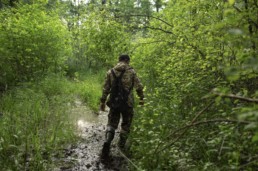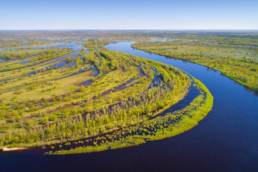The Search for European Mink in Almany
Last month, three biologists working with the Polesia – Wilderness without borders project set off into the vast Almany Mires. Their mission: to search for a particularly elusive species – the critically endangered European mink (Mustela lutreola). The species has not been sighted in Belarus for 20 years. Some suspect them to have been completely wiped out in the country, but if there is one place where these creatures could still be clinging to survival, it is the Almany Mires Nature Reserve.
The Almany Mires are still a rather poorly explored area. The reserve was expanded by 10,000 hectares in March this year – securing Europe’s largest intact transition mire and crucial habitat for globally threatened wildlife. The largely impassable and remote swamp could be acting as a refuge for the European mink.

What has led to this species’ disappearance from Belarus? In the 1930s, seven thousand American mink were brought to Europe, to the former USSR for the development of the fur trade. The American mink settled into its new landscape very well and soon began to outcompete the native European mink. Several decades later local hunters stopped seeing European mink. It remains unclear whether the species has now become extinct in the country.
Dmitry Shamovich , a zoologist and expert from the Polesia – Wilderness without borders project, set up 25 camera traps along the Stviga River and its tributaries in the hope that a European mink would be detected. Since minks are semi-aquatic animals, the camera traps were set up right next to the river and on drainage canals.

Dmitry explains that the European mink are not very mobile and usually do not venture further than a kilometre from watercourses. Some camera traps were also installed in the water, on metal and birch pegs, while others were fixed on trees on the river bank. Several weeks later the team returned to the Stviga by boat to collect and check the cameras.

On the shore, Viktar Fenchuk , an APB-Birdlife Belarus specialist and program coordinator of the Frankfurt Zoological Society in Belarus, explained:
“Stviga is the main water course of the Almany Mires Nature Reserve. Among the tributaries of the river there are many reclamation canals, which, although they are in a dilapidated state, still discharge water from the swamp, draining it.”
The project aims to strengthen the conservation status of the reserve. Wildlife is almost untouched here; there are very few places like this left in Europe. In addition, project specialists also monitor drained areas in the region and plan to block drainage channels and restore parts of the mire in the future.
Sadly, the first expedition in search of European mink ended without detection of the critically endangered species. The team will return in winter to again survey the Stviga and other parts of Almany, in the hope that the mink will still be found.














